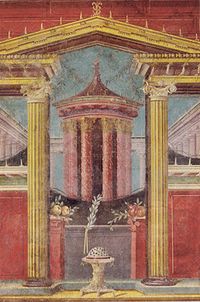
Boscoreale
Encyclopedia

Comune
In Italy, the comune is the basic administrative division, and may be properly approximated in casual speech by the English word township or municipality.-Importance and function:...
and town in the province of Naples
Province of Naples
The Province of Naples is a province in the Campania region of Italy. Its capital city is Naples, within the province there are 92 Comuni of the Province of Naples.-Demographics:...
, Campania
Campania
Campania is a region in southern Italy. The region has a population of around 5.8 million people, making it the second-most-populous region of Italy; its total area of 13,590 km² makes it the most densely populated region in the country...
, located in the Parco Nazionale del Vesuvio
Vesuvius National Park
Vesuvius National Park is a national park centered around the volcano, Mount Vesuvius, east of Naples, Italy. The park was founded in 1995 and covers an area of around 135 square kilometers all located within the Province of Naples....
under the slopes of Mount Vesuvius
Mount Vesuvius
Mount Vesuvius is a stratovolcano in the Gulf of Naples, Italy, about east of Naples and a short distance from the shore. It is the only volcano on the European mainland to have erupted within the last hundred years, although it is not currently erupting...
, known for the fruit and vineyards of Lacryma Christi del Vesuvio
Lacryma Christi
Lacryma Christi, , is the name of a celebrated Neapolitan type of wine produced on the slopes of Mount Vesuvius in Campania, Italy.-Origins of name:...
. There is also a fine Vesuvian lava stone production.
The neighborhood Monte Bursaccio, which was overcome by the eruption of Vesuvius in 79 CE that obliterated and preserved its better-known neighbors, Pompeii
Pompeii
The city of Pompeii is a partially buried Roman town-city near modern Naples in the Italian region of Campania, in the territory of the comune of Pompei. Along with Herculaneum, Pompeii was destroyed and completely buried during a long catastrophic eruption of the volcano Mount Vesuvius spanning...
and Herculaneum
Herculaneum
Herculaneum was an ancient Roman town destroyed by volcanic pyroclastic flows in AD 79, located in the territory of the current commune of Ercolano, in the Italian region of Campania in the shadow of Mt...
, is famous for the frescoes of its aristocratic villas
Roman villa
A Roman villa is a villa that was built or lived in during the Roman republic and the Roman Empire. A villa was originally a Roman country house built for the upper class...
, excavated before World War I. A hoard of Roman silver and coins that had been hurriedly stashed in a cistern for protection at the time of the eruption was also recovered in Boscoreale in 1895, and divided among museums, including the Louvre
Louvre
The Musée du Louvre – in English, the Louvre Museum or simply the Louvre – is one of the world's largest museums, the most visited art museum in the world and a historic monument. A central landmark of Paris, it is located on the Right Bank of the Seine in the 1st arrondissement...
.
Boscoreale, about a kilometer north of Pompeii of which it was an expansive, more rural outlying suburb, was notable in antiquity for having numerous aristocratic country villas and was preserved as a hunting park - hence its name, meaning "Royal Grove" - by the kings of Naples
Kingdom of Naples
The Kingdom of Naples, comprising the southern part of the Italian peninsula, was the remainder of the old Kingdom of Sicily after secession of the island of Sicily as a result of the Sicilian Vespers rebellion of 1282. Known to contemporaries as the Kingdom of Sicily, it is dubbed Kingdom of...
.
The villa of P. Fannius Synistor (see Villa Boscoreale
Villa Boscoreale
Villa Boscoreale is an ancient Roman villa located in the town of Boscoreale, about one and a half kilometers north of Pompeii, southwest of Vesuvius, in Campania, southern Italy. This area was a hunting reserve and also used agriculturally, specializing in wine and olive oil. Evidence in tablets...
) was built and decorated shortly after mid-first century BC. The quality of its frescoes seems to have preserved them from changes in fashion, before the villa was entombed in the eruption.
The Antiquarium of Boscoreale was founded in 1991 by the Soprintendenza archeologica di Pompei thanks to the finds from Pompeii, Herculaneum, Oplontis, Stabiae, Terzigno, and Boscoreale and to a didactic apparatus.
The neighboring Boscotrecase
Boscotrecase
Boscotrecase is a comune in the Province of Naples in the Italian region Campania, located about 20 km southeast of Naples...
yielded some elite works of art to excavators at the same time, in particular at the Villa of Agrippa Postumus, also known as the Imperial Villa or the Villa of Augusta.
External links
- Comune di Boscoreale official site
- Soprintendenza Archeologica di Pompeii: the main rustic villas
- Herculaneum/Pompeii/Stabiae Website
- AD79 Year of Destruction Website
- Frescos from the house of P. Fannius Synistor, Boscoreale (Metropolitan Museum of Art)
- Fresco section from the villa of Fannius Sinistor, Boscoreale (Archaeological Museum Naples
- Cubiculum from the house of P. Fannius Synistor, Boscoreale (Metropolitan Museum of Art)
- http://www.louvre.fr/llv/oeuvres/detail_notice.jsp;jsessionid=DLvp9DS4Spp6GG82TjJtLyrxF6hLQ0Gh2cQ9tLBwFJLGRG8WNDCJ!73989502?CONTENT%3C%3Ecnt_id=10134198673225345&CURRENT_LLV_NOTICE%3C%3Ecnt_id=10134198673225345&CURRENT_LLV_DEP%3C%3Efolder_id=1408474395181112&CURRENT_LLV_DIV%3C%3Efolder_id=2534374302024493&FOLDER%3C%3Efolder_id=9852723696500819&bmUID=1124806495041&bmLocale=enBoscoreale treasure (Musée du Louvre)]

